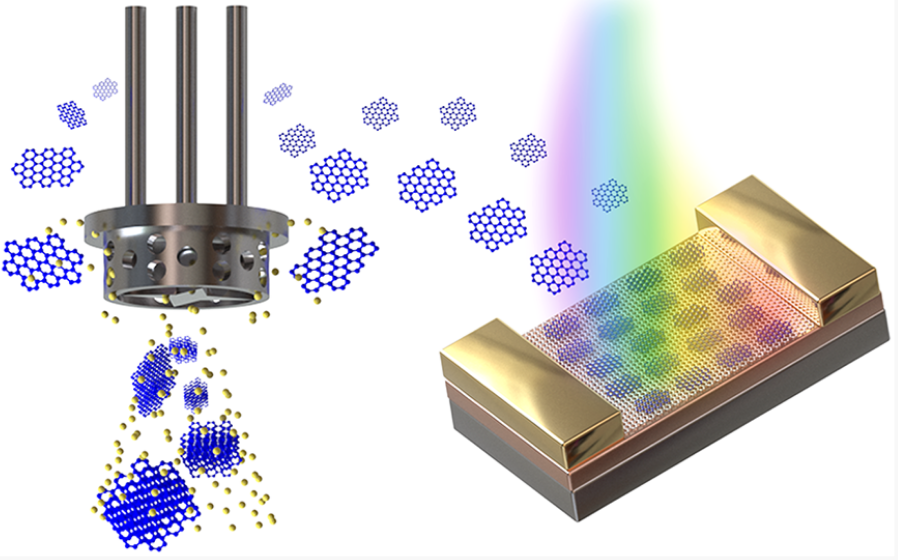 Our group has been involved in an interesting study of the photoconductivity of solution-processed nanographene ad-layers. Sensitization of graphene with inorganic semiconducting nanostructures has been demonstrated as a powerful strategy to boost its optoelectronic performance. However, the limited tunability of optical properties and toxicity of metal cations in the inorganic sensitizers prohibits their widespread applications, and the in-depth understanding of the essential interfacial charge-transfer process within such hybrid systems remains elusive. Here, we design and develop high-quality nanographene (NG) dispersions with a large-scale production using high-shear mixing exfoliation. The physisorption of these NG molecules onto graphene gives rise to the formation of graphene−NG van der Waals heterostructures (VDWHs), characterized by strong interlayer coupling through π−π interactions. As a proof of concept, photodetectors fabricated on the basis of such VDWHs show ultrahigh responsivity up to 4.5 × 107 A/W and a specific detectivity reaching 4.6 × 1013 Jones, being competitive with the highest values obtained for graphene-based photodetectors. The outstanding device characteristics are attributed to the efficient transfer of photogenerated holes from NGs to graphene and the long-lived charge separation at graphene−NG interfaces (beyond 1 ns), as elucidated by ultrafast terahertz (THz) spectroscopy. These results demonstrate the great potential of such graphene−NG VDWHs as prototypical building blocks for high-performance, low-toxicity optoelectronics. The study is published in https://doi.org/10.1021/jacs.1c07615.
Our group has been involved in an interesting study of the photoconductivity of solution-processed nanographene ad-layers. Sensitization of graphene with inorganic semiconducting nanostructures has been demonstrated as a powerful strategy to boost its optoelectronic performance. However, the limited tunability of optical properties and toxicity of metal cations in the inorganic sensitizers prohibits their widespread applications, and the in-depth understanding of the essential interfacial charge-transfer process within such hybrid systems remains elusive. Here, we design and develop high-quality nanographene (NG) dispersions with a large-scale production using high-shear mixing exfoliation. The physisorption of these NG molecules onto graphene gives rise to the formation of graphene−NG van der Waals heterostructures (VDWHs), characterized by strong interlayer coupling through π−π interactions. As a proof of concept, photodetectors fabricated on the basis of such VDWHs show ultrahigh responsivity up to 4.5 × 107 A/W and a specific detectivity reaching 4.6 × 1013 Jones, being competitive with the highest values obtained for graphene-based photodetectors. The outstanding device characteristics are attributed to the efficient transfer of photogenerated holes from NGs to graphene and the long-lived charge separation at graphene−NG interfaces (beyond 1 ns), as elucidated by ultrafast terahertz (THz) spectroscopy. These results demonstrate the great potential of such graphene−NG VDWHs as prototypical building blocks for high-performance, low-toxicity optoelectronics. The study is published in https://doi.org/10.1021/jacs.1c07615.
Archives
- May 2025
- July 2024
- March 2024
- August 2023
- June 2023
- November 2021
- April 2021
- March 2021
- January 2021
- December 2020
- September 2020
- May 2020
- December 2018
- November 2017
- September 2017
- August 2017
- March 2017
- January 2017
- October 2016
- June 2016
- October 2015
- March 2015
- October 2014
- April 2014
- January 2014
- June 2013
- May 2013
- January 2013
- September 2012
- July 2012
- June 2012
